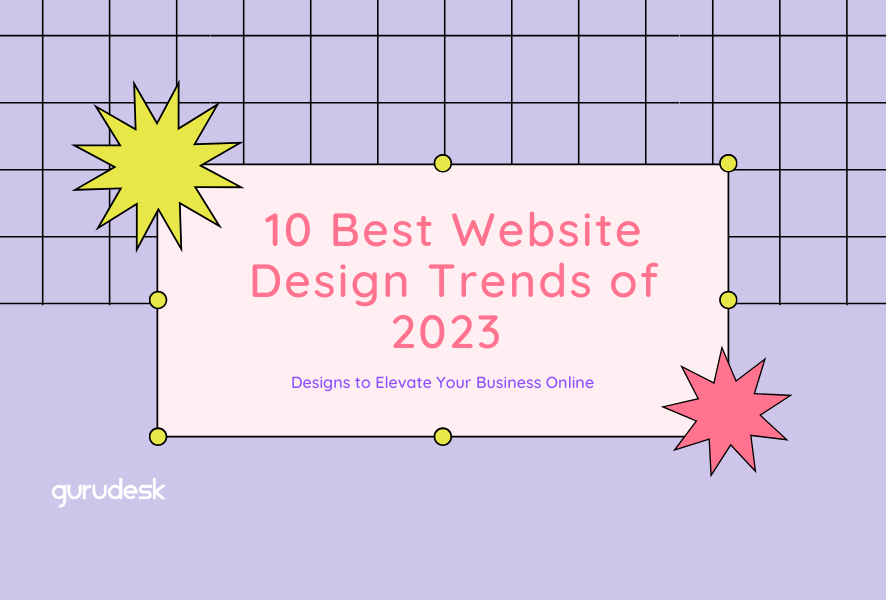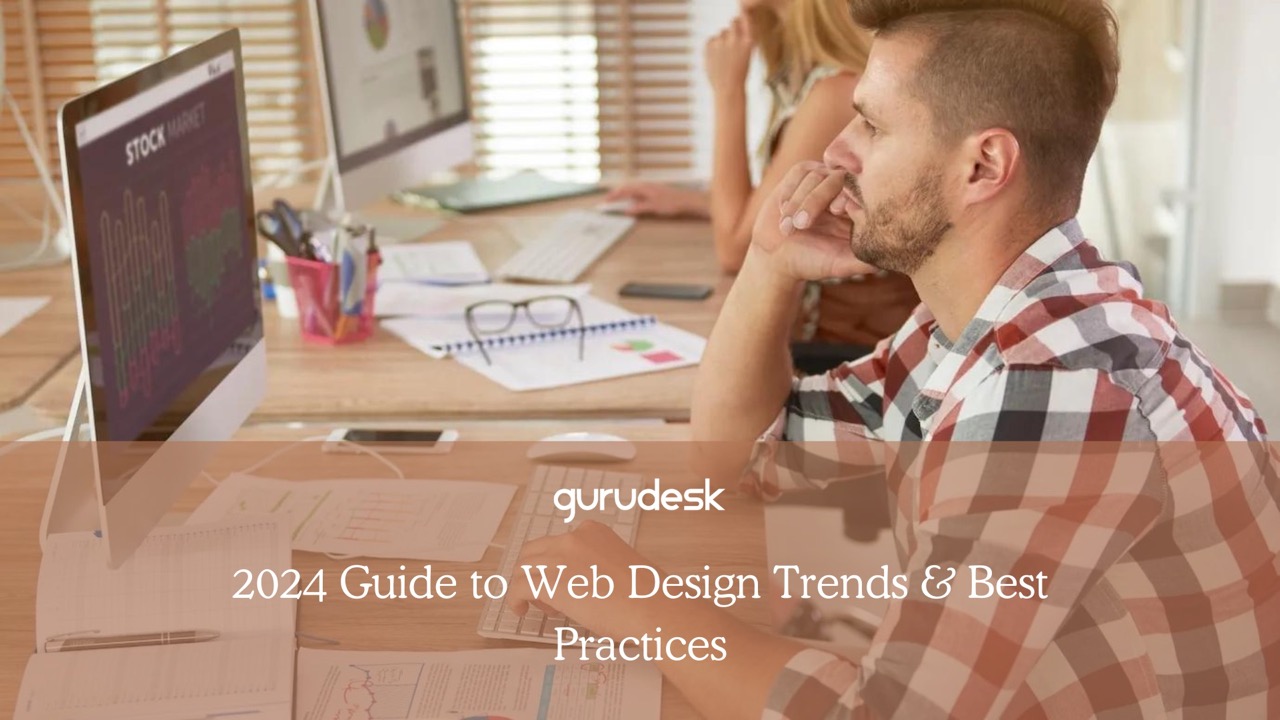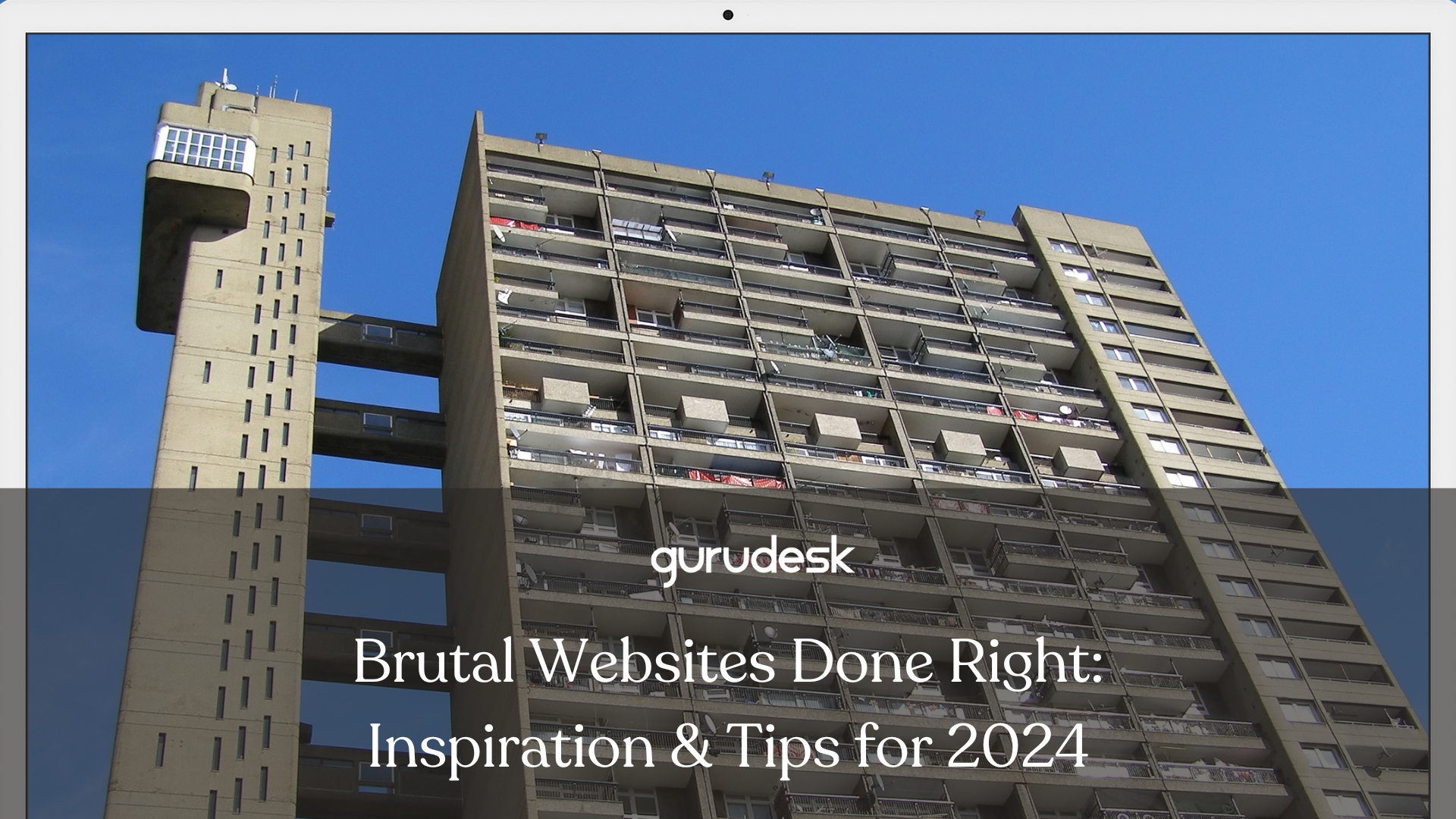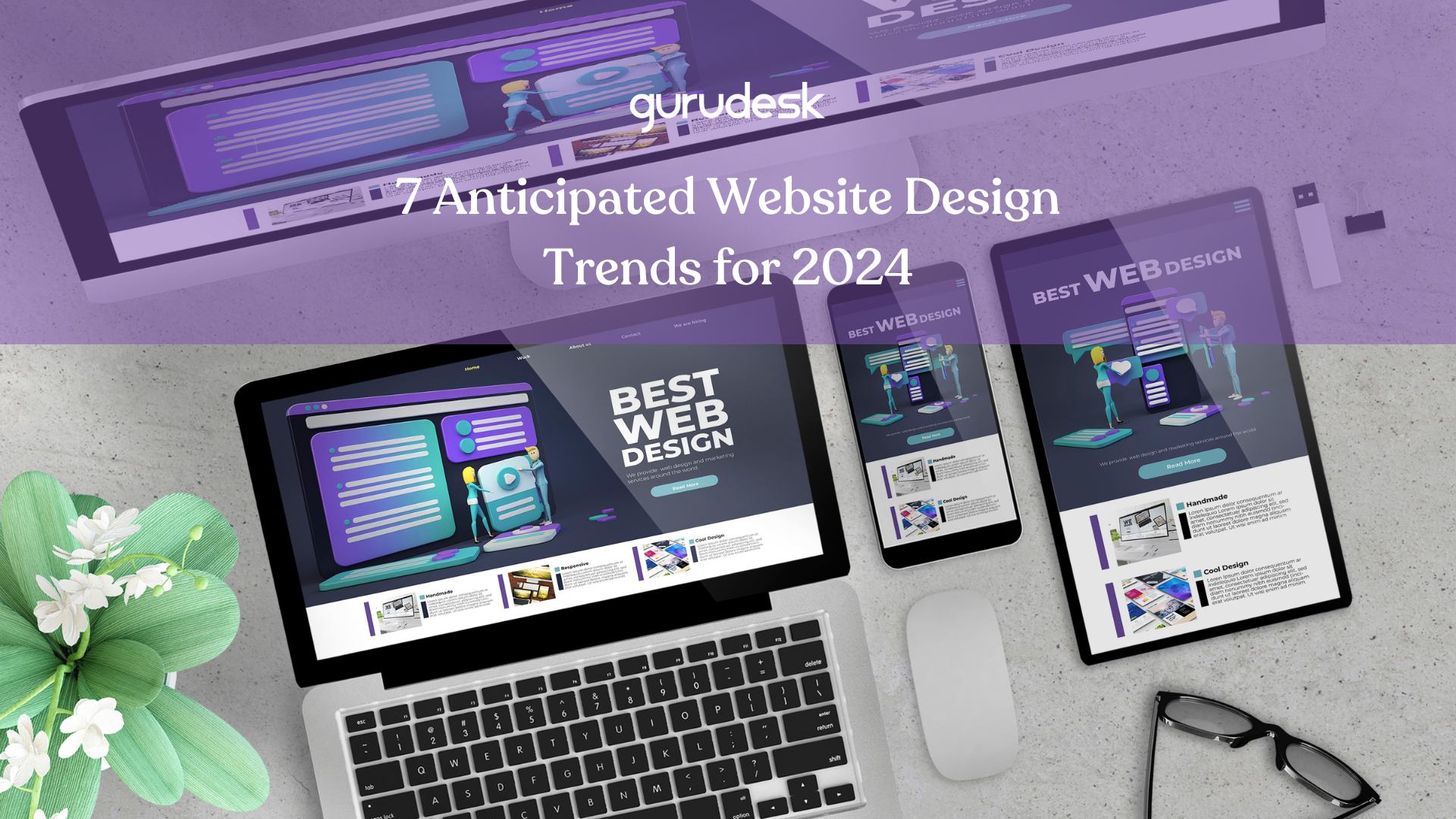
Website Design Trends are ever-shifting on the internet. As technology and user expectations evolve, so does the design landscape.
From bold use of color and typography to cutting-edge layouts and animations, the opportunities for creativity and innovation in website design have never been greater. The year 2023 is all about bringing the old and spicing it up.
Top 10 Best Website Design Trends for 2023
1. Over-stimulation
In 2023, digital maximalism is taking the web by storm, and it’s time to say goodbye to dull white spaces and hello to web pages bursting with animation, oversized typography, and unexpected splashes of color.
One of the driving forces behind this top web design trend is the use of oversized typography. By treating text as a graphic element, web designers can naturally make a bold statement and grab website visitors’ attention in an instant.
This technique works wonders in both minimalist and maximalist designs and can help tie all other design elements together.
Oversized typography offers:
- Functionality: By minimizing the use of images, oversized typography can significantly reduce loading times and improve mobile usability.
Hero Section
Instead of relying on images, designers are now using oversized typography to make a statement and capture the user’s attention from the moment they arrive.
2. Nostalgia and the Y2K aesthetic
As the Y2K aesthetic makes a comeback, designers and businesses alike can tap into nostalgia and make a lasting impression on their online audience. The Y2K aesthetic is about pushing the boundaries of web design and creating a truly unique user experience.
Through the use of default fonts, patterned backgrounds, old-school browser windows, simple layouts, and decorative sticker icons, you can transport visitors to the turn of the millennium and leave them with a sense of nostalgia and familiarity.
Rule Breaking Techniques
And as a business owner, you can differentiate yourself from the online noise and give your online presence a fresh, playful look. Incorporate features such as elements and vibrant colors to appeal to the customer base.
3. Memphis Design
Memphis design is one of the defining aesthetics of the 1980s. The Memphis Group, a group of architects and industrial designers from Milan, Italy, rejected the minimalist design style of the 60s and 70s and created a style centered around vibrant colors and a jumble of geometric shapes, stripes, and bold patterns.
It also promotes boldness and bravery, not only in design but in life. It reminds us that our time on earth should be fun, and it can help you make a lasting impression on your audience.
4. Illustrations with Dimensionality
In web design, illustrations are no longer just static images on a page. They’re being used to bring a new dimension of immersion and virtual reality to online spaces. Leading the charge in this movement are the innovative trends of 3D illustrations, Claymorphism, and the metaverse.
3D Illustrations
With 3D illustrations, designers are pushing the boundaries of what’s possible in web design by building full-on 3D visual experiences that pull users into cyberspace with site illustrations and animations, full-page effects, and multi-layered illustrations.
Redis Agency’s website is a prime example of this, where they’ve created a truly immersive and engaging experience by layering a parallax scrolling effect on top of their 3D illustrations.
Metaverse
The metaverse is the next frontier in web design, and it’s rapidly becoming an increasingly important part of the visual language of web design. Websites are taking inspiration from the metaverse to create cohesive 3D worlds that include everything from illustrations, backgrounds, text, and even cursors.
These sites are also incorporating animations and interactive elements to make the experience feel even more engaging.
Claymorphism
The claymorphism trend is sweeping the web design industry, bringing a dynamic, tangible, and realistic experience to the forefront. Sites like Webflow’s Community Grants page showcase the true potential of this trend, infusing websites with energy and vitality.
5. Animated Designs
One of the website design trends for 2023 is the use of animated illustrations, such as animated opening titles. Businesses are turning to talented illustrators and graphic artists to craft custom illustrations that truly embody their brand and offerings.
These illustrations are often imbued with animation, creating an interactive and engaging experience for users and increasing their ability to retain information and keep their attention for longer periods of time.
Shorter Attention Spans
By using small, moving designs for background images, designers can create a sense of movement and dynamism on websites, drawing visitors in and inviting them to spend more time browsing the site.
Another website design trend that is gaining popularity in the animated web design world is the use of interactive product displays, in which designers can incorporate hover or rollover effects, hyper movement, fancy transitions, or playful animations, but it is important to exercise caution and avoid clutter and image overload.
6. Parallax Zoom Scrolling
This animation technique creates a sense of realism and depth by having the foreground elements move faster than the background elements, making the user experience more immersive and captivating.
Instead of vertical or horizontal scrolling, parallax zoom scrolling takes the visitor inward or outward from the horizon line, creating a sudden three-dimensional movement.
It’s like taking your visitors on a journey—a ride into the unknown—where they can explore the depths of your website and uncover the hidden gems of your brand.
Create an Illusion of Depth
Creating an illusion of depth makes the experience more immersive and fascinating. This means that users will stay longer on your website and engage better with your brand, which ultimately leads to more conversions.
However, it’s important to note that the success of the parallax effect depends on the loading time of the website. That’s why, for larger projects, subtle parallaxes are recommended to minimize the load on the website and not affect loading times, or choose reliable web hosting providers like GuruDesk.
7. ’90s navigation
The 90s were a defining decade for the internet, marking the beginning of a new era of digital communication and information sharing.
Designers are now tapping into this nostalgia to create websites that are both familiar and inviting to users. One prime example of this is the record-store-themed navigation design created by 99designs by Vista designer Marijn B.
This nostalgic design creates a sense of warmth and familiarity for the user, drawing them in and immersing them in the experience.
Sense of Appeal
Styles rely on sense memory to create an intuitive and familiar experience for the user, making the website feel like a comforting trip down memory lane.
The nostalgic design reels in the old and the young to experience or re-experience the true essence of the 1990s. The use of nostalgia creates a digital facsimile of a world that they may not have known, but that still holds a certain allure.
8. Abstract Illustrations
Abstract illustrations with a more organic and hand-drawn feel are taking over web design. This style of illustration can be achieved through a variety of means, such as sketching on paper, scanning, or using illustration software.
The key is to incorporate various textures and natural variations, like those found in watercolor, ink, paint, or even the texture of the paper. Softening lines and mimicking the variations found in graphite or ink further add to the organic feel.
Designer Adam Ho‘s illustrations perfectly demonstrate the complexity that can be achieved with this style. With their thin lines and graphic shapes, they resemble technical drawings without representing any specific object.
Use of geometric shapes
Geometric shapes are commonly used as primary images for websites, apps, social media posts, and packaging designs. Their appeal lies in their vividness and contrast, minimalist simplicity, and overall visual aesthetics.
Abstract illustrations and geometric shapes have also been used in branding, drawing attention to the brand name through color and form. They are increasingly used in branding and visual aesthetics for websites and other designs, adding depth and complexity to the overall look.
9. Gradients with Grain
The traditional gradient gives a sleek, modern look, providing a futuristic glow or a shiny, technological feel. But by introducing grain, the design is given texture, making it feel more natural, ranking 9th in the 10 best web design trends of 2023.
Designers can use grain to mimic various mediums, such as film, photography, or print. A fine, multi-color grain can resemble analog film, while a larger, monochrome grain can look like a silk-screened poster.
Depending on the desired effect, grain and gradients can be used selectively, across the entire page as a full background, or within specific objects. A great example of this trend in action is the website for the Webflow 2021 No-Code Conference; it features several grainy gradients in animated graphics, backgrounds, and elements throughout the conference page, giving it a print-media-like effect.
1. Complex gradients
In 2023, complex gradients will be one of the most sought-after web design trends. They add depth to flat images and offer more room for creativity. Gradients made a comeback in 2018 with Instagram’s gradient logo, and since then they have set new standards for creativity and interactivity.
They also offer the ability to create an illusion of movement, making them a powerful tool for web designers. They create a sense of motion without the need for animation.
2. Monochromatic gradients
Monochromatic gradients have also been a popular trend in recent years, giving a sense of depth and visual interest without being too distracting.
A creative studio like Better Half illustrates a perfect example of how this trend can be used in a fresh and modern way, combining bold typography and hover animations with a monochromatic, pastel yellow gradient background.
Tips for Using Gradients
When using gradients in website design, it’s important to find the right balance. Gradients can be used for small elements like logos or icons to make them stand out, but care should be taken not to detract from other design elements on the website.
Gradients can be used for larger elements but should be used in a way that does not make the other content less visible. It’s important to separate the various sections of the page and make the content more readable.
10. Linework
Linework, the final of the 10 best website design trends of 2023, is a bold and dynamic trend that is making waves in the world of website design. Linework illustrations, whether abstract or representational, fuse together the best of modern and vintage design, using lines to create visually interesting and sophisticated layouts.
Line weight
One of the most striking elements of linework design is the use of line weight. This refers to the thickness of the lines used in the design, and it can have a profound impact on the final aesthetic.
For instance, Appart Agency’s website uses ultrafine lines to achieve a technical, sharp, and minimalist look that harks back to the Minimalist art movement of the 1960s.
The horizontal lines on the site also move as the user scrolls, adding an extra touch of dynamic movement. By using lines to create geometric shapes, designers can achieve a clean and sophisticated look that evokes high technology, architecture, and real estate.
This style can be highly minimalist, almost appearing unfinished, but the use of lines in this way often adds a sense of cleanliness and simplicity to the design.
But it’s not just about aesthetics, Linework also prioritizes performance, allowing for the perfect balance between form and function. By focusing on a sleek, uncluttered design, linework allows websites to load quickly and be easy to navigate, resulting in a more seamless user experience.
GuruDesk UI/UX Website Design
Intending to bring your vision to life, Guru designers don’t just follow trends; they master them. Our UI/UX services involve thorough analysis of business and user needs to pin point and create a user journey map, whilst incorporating design elements chosen.
Through designing the structure, layout, and organization, customers are able to enjoy a more intuitive user interface that is user friendly.
Influence of Website Design Trends
Performance
Affects how quick and smooth a website loads and responds to user interactions.
- Image Optimization: High-resolution images and graphics can slow down a website’s loading speed.
- Caching and Content Delivery: Design can influence how caching mechanisms and content delivery networks are implemented by storing copies of the website on servers closer to the user’s location.
SEO
Search Engine Optimization is highly important since it is the process by which a website is able to rank higher in search engine results.
- Navigation: Clear navigation helps search engines understand the content hierarchy of the website.
- Mobile-friendly Design: Responsive designs are vital to helping search engines understand the website’s content, leading to richer search results.
- Page Speed: If a page takes longer than 3 seconds to load, chances are you will lose your customer. It is important for your website pages, media, and links to be optimized for better page speed.
Uptime
Referring to the amount of time that the website is accessible and operational to the general public, uptime can be indirectly affected by:
- Hosting and Server Choice: Your hosting provider and their server may have an indirect affect through their uptime percentage. Choose a provider with 99.9% uptime to ensure minimum downtime.
Website Design Trends
In this ever changing world, it is necessary to have interactive elements that offer your customers the chance at connecting with your business.
Keep in mind that you can access these design trends through WordPress Themes, as well! Clear differentiation makes sites more appealing, allowing for a unique and individual experience.
Enhance user experience, add vertical scrolling, maybe even white spaces to add depth and stand out. With the best website design trends, you have the the general foundation of making your website look more authentic, and more you!
Join the GuruDesk community and be among the first ones to discover the hottest trends in web services! We are a team of web experts and we love sharing our knowledge and experience with our readers! We share tips and tricks on a wide range of topics, including web development, cloud services, and hosting. Whether you are a seasoned pro or just starting out, we promise you will find valuable information here. So go ahead, hit that “Subscribe” button and let the fun begin!






